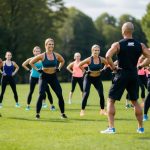Flexibility Training: Stretching Exercises for Home Fitness
Incorporating Flexibility Training into Your Routine
Flexibility training can seamlessly integrate into daily life, enhancing mobility and reducing the risk of injury. Key approaches include establishing daily stretching habits and developing a structured flexibility training schedule.
Daily Stretching Habits
Integrating stretching into daily routines is crucial for maintaining flexibility. Start with simple stretches each morning and evening to loosen muscles. Focus on major muscle groups: hamstrings, quads, shoulders, and back.
Consistency is key. Make it a habit to stretch for at least 5-10 minutes. Pair stretching with other daily activities; for example, stretch while watching TV. This makes it easier to sustain.
Listen to the body. Avoid over-stretching which can cause injury. Gentle, controlled movements are effective. Over time, increase the intensity and duration of stretches for better results.
Flexibility Training Schedules
Creating a flexibility training schedule helps in systematically improving flexibility. Allocate specific days and times dedicated to stretching exercises. Aim for flexibility workouts 3-5 times a week, interspersed with other forms of exercise.
Incorporate a variety of stretches targeting different muscle groups. Dynamic stretches are useful before workouts, while static stretches help post-workout. Consider adding yoga or Pilates sessions once or twice a week for comprehensive flexibility training.
Tracking progress is beneficial. Note improvements in range of motion and reduced muscle stiffness. Adjust the routine based on progress and changing fitness goals.
Tools and Equipment to Enhance Stretching
Using certain tools can greatly improve the effectiveness of your stretching routine. These tools not only help in targeting specific muscles but also assist in achieving deeper and more precise stretches.
Foam Rollers
Foam rollers are cylindrical pieces of foam used for self-myofascial release, which means self-massage. They work by applying pressure to tight muscles and fascia, helping to break down knots and increase blood flow.
Using foam rollers can significantly reduce muscle soreness and improve flexibility. They are available in various densities, from soft to firm, allowing users to select one that best suits their pain tolerance and stretching needs. Rollers with textured surfaces can provide a deeper tissue massage compared to flat ones.
Incorporating a foam roller into your routine can help in both pre-workout and post-workout stretches. Rolling out major muscle groups like the calves, quads, and back for a few minutes can prepare the body for activity and aid recovery post-exercise.
Stretching Straps
Stretching straps, also known as yoga straps, are versatile tools designed to help achieve and maintain proper stretch positions. These straps are typically made from durable fabric with multiple loops or buckles for adjusting length and tension.
They enable users to hold stretches longer and with proper alignment, which is crucial for preventing injuries. Straps are particularly useful for stretches that require flexibility in the hamstrings, shoulders, and back. For example, lying on your back and looping the strap around your foot can help you perform a seated forward bend more effectively.
Using a stretching strap can also increase the range of motion over time by allowing gradual progression into deeper stretches. This is beneficial for both beginners who might need additional support and advanced practitioners aiming for more challenging positions.
Yoga Blocks
Yoga blocks are rectangular bricks made from foam, cork, or wood, designed to provide support and stability during stretching exercises. They are particularly helpful in yoga poses by shortening the distance between the body and the ground, making stretches more accessible.
When using a yoga block, individuals can focus on maintaining proper form without overextending, which reduces the risk of strain. Blocks come in different sizes and densities, allowing users to choose the right level of support.
Incorporating yoga blocks into a stretching routine can enhance balance and flexibility. For instance, placing a block under the hand in a triangle pose can help maintain alignment and deepen the stretch in a controlled manner.
Yoga blocks also facilitate seated postures, helping those with tight hips or lower back issues to sit comfortably and perform stretches effectively.



